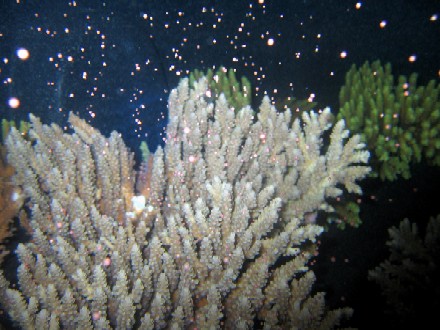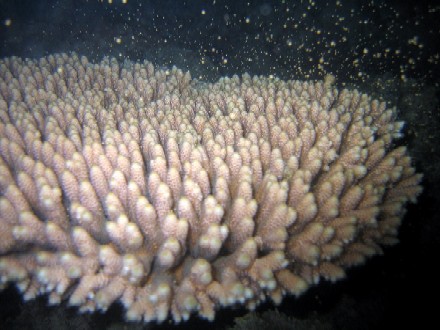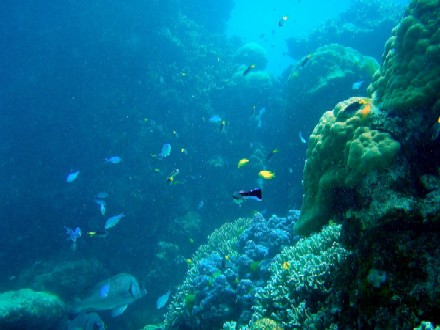Navigation
Possible Moonlight Trigger Found for Annual Mass Spawning of Corals
An international team of Australian and Israeli researchers has discovered what could be the aphrodisiac for the biggest moonlight sex event on Earth.
 |
| Corals spawning at night on the Great Barrier Reef |
An international team of Australian and Israeli researchers has discovered what could be the aphrodisiac for the biggest moonlight sex event on Earth.
An ancient light-sensitive gene has been isolated by researchers from the ARC Centre of Excellence for Coral Reef Studies (CoECRS) that appears to act as a trigger for the annual mass spawning of corals across a third of a million square kilometres of Australia’s Great Barrier Reef, shortly after a full moon.
The genes, known as a cryptochromes, occur in corals, insects, fish and mammals - including humans - and are primitive light-sensing pigment mechanisms which predate the evolution of eyes.
In a new paper published in the international journal Science on October 19, 2007, the team, headed by Marie Curie Scholar Dr Oren Levy of CoECRS and the University of Queensland, reports its discovery that the Cry2 gene, stimulated by the faint blue light of the full moon, appears to play a central role in triggering the mass coral spawning event, one of nature’s wonders.
Professor Ove Hoegh-Guldberg, who leads the University of Queensland laboratory in which the genes were discovered, said “This is the key to one of the central mysteries of coral reefs. We have always wondered how corals without eyes can detect moonlight and get the precise hour of the right couple of days each year to spawn.”
 |
| Corals of the same species synchronise their spawning to within the same hour |
 |
| The Larvae then settle and grow to help form the reefs |
What allows corals to spawn simultaneously along the immense length of the Great Barrier Reef - and also in other parts of the world - has been a scientific mystery till now, though researchers knew that tide, water temperature and weather conditions played a part, says Dr Levy. However the remarkable synchronisation of spawning occurring all along the Reef immediately following a full moon suggested that moonlight was a key factor.
Exposing corals to different colours and intensities of light and sampling live corals on reefs around the time of the full moon, Dr Levy found the Cry2 gene at its most active in Acropora corals during full moon nights. “We think these genes developed in primitive life forms in the Precambrian, more than 500 million years ago, as a way of sensing light,” he explains. “The fact they are linked with the system that repairs damage from ultraviolet (UV) radiation suggests they may evolved in eyeless creatures which needed to avoid high daytime UV by living deep in the water, but still needed to sense the blue light shed by the moon to synchronise their body clocks and breeding cycles.”
“They are, in a sense, the functional forerunners of eyes,” Professor Hoegh-Guldberg said. In humans, cryptochromes still operate as part of the circadian system that tunes us to the rhythms of our planet, though their light-sensing function appears lost to us, he went on to explain.
“They play important roles in regulating the body-clocks of many species, from corals to fruit flies, to zebra fish and mice. The proteins they produce are similar to those in humans and other mammals, though they appear to function more like those in the fruit fly,” says Professor David Miller of CoECRS and JCU.
The coral cryptochrome genes were initially identified by Dr Levy and Dr Bill Leggat working with Professor Hoegh-Guldberg (UQ) on Heron Island. Prof. Miller and Dr David Hayward, of the Australian National University, were able to add information on the coral cryptochromes from a large library of coral genes that they have been compiling (so far they have catalogued about 10,000 out of an estimated 20-25,000 genes in coral), and leading circadian clock biologists from Bar-Ilan and Tel-Aviv Universities in Israel played important roles in interpreting the data.
“Many of these genes developed in deep time, in the earliest phases of organised life on the planet,” Dr Leggat says. “They were preserved for hundreds of millions of years before being inherited by corals when they developed about 240 million years ago, and are still found today in modern animals and humans. They are an indicator that corals and humans are in fact distant relatives, sharing a common ancestor way back.”
Whether they have anything at all to do with human associations between the full moon and romance is not known, but cryptochromes probably still play a part in our body clock.
The ARC Centre of Excellence for Coral Reef Studies, 19 October 2007is responsible for the contents of this article and for the photographs they generously made available.
Link to Full Text of the Paper http://www.sciencemag.org/cgi/content/abstract/318/5849/467
More information:
Dr Oren Levy, Israel, BIU
+972-3-5318570 or +972-50-4082825
Professor Ove Hoegh-Guldberg, CoECRS and UQ
ph +61 (0)7 3365 1156 or 0401 106 604
Dr Bill Leggat, CoECRS and JCU
, +61 (0)415 253 820
Professor David Miller, CoECRS and JCU,
+61 (0)7 4781 4473 or 0419 671 768
Jenny Lappin, CoECRS,
+61 (0)417 741 638
Jan King, UQ Communications Manager,
+61 (0)7 3365 1120, 0413 601 248
Jim O’Brien, James Cook University Media Office,
+61 (0)7 4781 4822
Note:
Learn more about coral reefs at Horizon International’s Magic Porthole™ preview at www.magicporthole.org.
Search
Latest articles
Agriculture
- World Water Week: Healthy ecosystems essential to human health: from coronavirus to malnutrition Online session Wednesday 24 August 17:00-18:20
- World Water Week: Healthy ecosystems essential to human health: from coronavirus to malnutrition Online session Wednesday 24 August 17:00-18:20
Air Pollution
- "Water and Sanitation-Related Diseases and the Changing Environment: Challenges, Interventions, and Preventive Measures" Volume 2 Is Now Available
- Global Innovation Exchange Co-Created by Horizon International, USAID, Bill and Melinda Gates Foundation and Others
Biodiversity
- It is time for international mobilization against climate change
- World Water Week: Healthy ecosystems essential to human health: from coronavirus to malnutrition Online session Wednesday 24 August 17:00-18:20
Desertification
- World Water Week: Healthy ecosystems essential to human health: from coronavirus to malnutrition Online session Wednesday 24 August 17:00-18:20
- UN Food Systems Summit Receives Over 1,200 Ideas to Help Meet Sustainable Development Goals
Endangered Species
- Mangrove Action Project Collaborates to Restore and Preserve Mangrove Ecosystems
- Coral Research in Palau offers a “Glimmer of Hope”
Energy
- Global Innovation Exchange Co-Created by Horizon International, USAID, Bill and Melinda Gates Foundation and Others
- Wildlife Preservation in Southeast Nova Scotia
Exhibits
- Global Innovation Exchange Co-Created by Horizon International, USAID, Bill and Melinda Gates Foundation and Others
- Coral Reefs
Forests
- NASA Satellites Reveal Major Shifts in Global Freshwater Updated June 2020
- Global Innovation Exchange Co-Created by Horizon International, USAID, Bill and Melinda Gates Foundation and Others
Global Climate Change
- It is time for international mobilization against climate change
- It is time for international mobilization against climate change
Global Health
- World Water Week: Healthy ecosystems essential to human health: from coronavirus to malnutrition Online session Wednesday 24 August 17:00-18:20
- More than 400 schoolgirls, family and teachers rescued from Afghanistan by small coalition
Industry
- "Water and Sanitation-Related Diseases and the Changing Environment: Challenges, Interventions, and Preventive Measures" Volume 2 Is Now Available
- Global Innovation Exchange Co-Created by Horizon International, USAID, Bill and Melinda Gates Foundation and Others
Natural Disaster Relief
- STOP ATTACKS ON HEALTH CARE IN UKRAINE
- Global Innovation Exchange Co-Created by Horizon International, USAID, Bill and Melinda Gates Foundation and Others
News and Special Reports
- World Water Week: Healthy ecosystems essential to human health: from coronavirus to malnutrition Online session Wednesday 24 August 17:00-18:20
- STOP ATTACKS ON HEALTH CARE IN UKRAINE
Oceans, Coral Reefs
- World Water Week: Healthy ecosystems essential to human health: from coronavirus to malnutrition Online session Wednesday 24 August 17:00-18:20
- Mangrove Action Project Collaborates to Restore and Preserve Mangrove Ecosystems
Pollution
- Zakaria Ouedraogo of Burkina Faso Produces Film “Nzoue Fiyen: Water Not Drinkable”
- "Water and Sanitation-Related Diseases and the Changing Environment: Challenges, Interventions, and Preventive Measures" Volume 2 Is Now Available
Population
- "Water and Sanitation-Related Diseases and the Changing Environment: Challenges, Interventions, and Preventive Measures" Volume 2 Is Now Available
- "Water and Sanitation-Related Diseases and the Changing Environment: Challenges, Interventions, and Preventive Measures" Volume 2 Is Now Available
Public Health
- Honouring the visionary behind India’s sanitation revolution
- Honouring the visionary behind India’s sanitation revolution
Rivers
- World Water Week: Healthy ecosystems essential to human health: from coronavirus to malnutrition Online session Wednesday 24 August 17:00-18:20
- Mangrove Action Project Collaborates to Restore and Preserve Mangrove Ecosystems
Sanitation
- Honouring the visionary behind India’s sanitation revolution
- Honouring the visionary behind India’s sanitation revolution
Toxic Chemicals
- "Water and Sanitation-Related Diseases and the Changing Environment: Challenges, Interventions, and Preventive Measures" Volume 2 Is Now Available
- Actions to Prevent Polluted Drinking Water in the United States
Transportation
- "Water and Sanitation-Related Diseases and the Changing Environment: Challenges, Interventions, and Preventive Measures" Volume 2 Is Now Available
- Urbanization Provides Opportunities for Transition to a Green Economy, Says New Report
Waste Management
- Honouring the visionary behind India’s sanitation revolution
- Honouring the visionary behind India’s sanitation revolution
Water
- Honouring the visionary behind India’s sanitation revolution
- Honouring the visionary behind India’s sanitation revolution
Water and Sanitation
- Honouring the visionary behind India’s sanitation revolution
- Honouring the visionary behind India’s sanitation revolution

